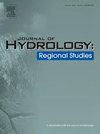伊朗西南部地下水水化学及烃污染岩溶含水层成因研究
IF 4.7
2区 地球科学
Q1 WATER RESOURCES
引用次数: 0
摘要
研究地区:伊朗西南部的胡齐斯坦、伊拉姆、洛斯坦、查哈尔马哈尔和巴赫蒂亚里省。本研究对2021年2月、2021年8月和2022年2月在伊朗西南部采集的样品进行了常规地球化学、水(δ2H, δ18O)、SO4 (δ34S, δ18O)和溶解无机碳(δ13CDIC)稳定同位素分析。利用水文地球化学图对岩溶含水层中的含硫样品(SS)、非含硫样品(NSS)和油田水(OFW)样品进行了区分。结果表明:(1)SS、NSS和OFW样品的主要化学成分分别为CaSO4、CaHCO3和NaCl类型;(2) SS和NSS的δ 2oh2o值在−17.37 ~−15.86 ‰V-SMOW之间,δ18OH2O值在−4.49 ~−4.18 ‰V-SMOW之间,表明它们来源于局地雨水;(3) SS、NSS和OFW的溶解硫酸盐的δ34SSO4和δ18OSO4值表明,硫酸盐是由水与岩石,特别是石膏和硬石膏等蒸发岩相互作用产生的;(4) δ13CDIC值变化较大,范围为−16 ‰~ + 7 ‰V-PDB。较高的δ13CDIC特征与生物地球化学过程(即甲烷生成)或与海相碳酸盐交换相一致。(5)地下水样品中总石油烃(TPH)浓度在26.3 ~ 19670 μg/L之间。在所有样品中,甲苯是最丰富的BTEX物种。本文章由计算机程序翻译,如有差异,请以英文原文为准。
Insights into groundwater hydrochemistry and origin of the hydrocarbon contaminated karst aquifers, SW Iran
Study region
Khuzestan, Ilam, Lorestan, and Chaharmahal and Bakhtiari provinces in southwest of Iran.
Study focus
In this study, conventional geochemical, stable isotopes of H2O (δ2H, δ18O), SO4 (δ34S, δ18O), and dissolved inorganic carbon (δ13CDIC) were employed on the samples collected in February 2021, August 2021, and February 2022 from SW Iran. By the use of hydrogeochemical diagrams, sulfuric samples (SS), non-sulfuric samples (NSS), and oil field water (OFW) samples in karst aquifers have been distinguished.
New hydrological insights for the region
The findings reveal that: (1) the major chemical composition of the SS, NSS, and OFW samples consist of CaSO4, CaHCO3, and NaCl types, respectively; (2) the δ2HH2O values range between −17.37 and −15.86 ‰ V-SMOW and the δ18OH2O values range between −4.49 and −4.18 ‰ V-SMOW for the SS and NSS, indicating that they originated from local rainwater; (3) the δ34SSO4 and δ18OSO4 values of dissolved sulfate of SS, NSS, and OFW indicate that the sulfate resulted from interactions between water and rocks, particularly evaporitic rocks such as gypsum and anhydrite; and (4) the δ13CDIC values vary extensively, ranging from −16 ‰ to + 7 ‰ V-PDB. Higher δ13CDIC signatures are consistent with biogeochemical processes (i.e., methanogenesis) or exchange with marine carbonates. (5) The concentration of total petroleum hydrocarbons (TPH) ranged from 26.3 to 19,670 μg/L in the groundwater samples.Toluene was the most abundant species of BTEX in all samples.
求助全文
通过发布文献求助,成功后即可免费获取论文全文。
去求助
来源期刊

Journal of Hydrology-Regional Studies
Earth and Planetary Sciences-Earth and Planetary Sciences (miscellaneous)
CiteScore
6.70
自引率
8.50%
发文量
284
审稿时长
60 days
期刊介绍:
Journal of Hydrology: Regional Studies publishes original research papers enhancing the science of hydrology and aiming at region-specific problems, past and future conditions, analysis, review and solutions. The journal particularly welcomes research papers that deliver new insights into region-specific hydrological processes and responses to changing conditions, as well as contributions that incorporate interdisciplinarity and translational science.
 求助内容:
求助内容: 应助结果提醒方式:
应助结果提醒方式:


